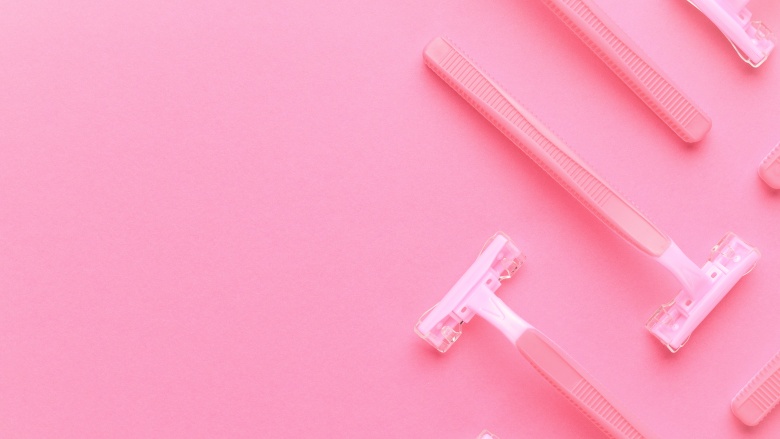The Real Reasons You Should Stop Shaving
Finally! Winter is here, and we can give our overused razors a rest. Most of us put our delicate skin through trauma on a daily basis and don't even realize it. Shaving is not only annoying and time-consuming, it can be downright dangerous.
We spoke with cosmetic dermatologist and medical director of Juverne Dr. Sonam Yadav about why he tells his patients to stop shaving. "It's tedious, monotonous and wasteful," he said. "The constant friction causes skin dryness and the angle of cutting hair promotes ingrown hair and bumps." So crank up your heated mattress pad, throw on your fleece pajamas, and embrace the fuzz. Here are just a few reasons why it's time to ditch the razor.
Enough is enough
As if we weren't all addicted to shaving already, there's a new body part you need to worry about. Dermatologist Dr. Michael Swann spoke with Good Housekeeping about one of shaving's latest trends – women shaving their faces! What?? I first learned about this trend by watching one of Bravo's reality shows. One of the male stars was boasting about his perfect skin and attributed it to shaving his entire face, forehead included. Now women are getting in on the action. "It definitely exfoliates your face when you shave," Swann says. "If you have small growths on your face, it will plane them off."
Now don't lather your face up just yet. Shaving irritates your skin while putting you at risk for infection, so instead of jumping on the face-shaving train, buy yourself a first class ticket to peach fuzz city.
Your skin is sensitive
One of the obvious drawbacks to shaving is skin irritation. Who hasn't suffered through bright red razor burn or ingrown hairs in the name of beauty? Unfortunately one of the most common areas to shave is also one of the most sensitive. Hibba Kapil, founder of Hibba NYC, spoke with Bustle about why shaving our underarms is harmful for that sensitive skin. "Because the area never catches a break from shaving, it's always going to have bumps or ingrown hairs," she explained.
Sure these bumps are a little painful, but what's the big deal? The problem is they can lead to infection. "Shaving can cause bumps, blisters and pimples," explains Kapil. "However if you aren't careful, it can cause folliculitis [an infection caused by bacteria Staphylococcus or fungus], which is caused by recently-shaved hairs regrowing out of the follicle, and curling back around to irritate the skin." Oh, no thank you.
It turns out every time we shave, we're removing a tiny layer of skin. Not only does that sound painful, but let's not forget our skin is there for a reason. "If you shave or wax too soon or frequently, you may irritate or traumatize the skin and that is painful," New York based dermatologist Dr. David Bank told Bustle. "It's important not to shave too frequently as this can lead to stripping away the skin's outer protective barrier layer. If that happens, the skin is more vulnerable to irritation and infections."
You could end up in the ER
Researchers at the University of California, San Francisco studied the characteristics of patients coming to the Emergency Department for genital-related injuries from 2002 to 2010. The authors found the number of women reporting vaginal injuries (yikes!) increased by six times over that period, and they attribute that finding to shaving. I think we can all agree the smooth skin shaving gives us for a hot minute is certainly not worth a trip to the hospital. Benjamin Breyer, MD, assistant professor at the University of California, San Francisco told Prevention it's not uncommon to injure yourself when trying to shave your bikini area. "The pubic region has lots of curves, making it more challenging to remove hair," he explained. "It's a lot different from shaving a flat surface, like your legs."
Shaving down below can lead to injury from the razor blade, but it can also lead to other problems. If our bodies naturally grow pubic hair, it's probably there for a reason. Los Angeles OB GYN Suzanne Gilberg-Lenz, M.D. spoke with Women's Health about the risks of shaving below the belt. "When you shave, each hair follicle becomes raised—and when the area isn't smooth you may be more likely to nick yourself with the razor," she explains. "Anything that's living on the skin should stay on the skin and not go inside the tissue — with open cuts you can get a bigger infection than you would otherwise."
Bottom line? Either skip the pubic hair removal all together or look into other methods such as hair removal creams or laser hair removal.
Infection city
Not only are those shaving injuries sounding worse and worse, but they can put you at risk for some serious infections below the belt. According to a study in the American Journal of Gynecology, over 50 percent of American women report removing pubic hair whether it's by shaving, waxing, or laser hair removal.
The authors reported the most common method of removing pubic hair is shaving. "The popularity of this method is probably related to the fact that shaving is a low-cost, easy-to-access method that can be done in the privacy of one's home," they explained. "Although we did not determine the method being used when injuries occurred, we found a large majority of complications related to pubic hair removal occurred among women who had shaved with a razor. This could have been due to the frequency of using the razors or because shaving all areas of the pubic region is more difficult and exposes more sensitive vulvar regions to trauma." Don't you just want to cross your legs a little tighter when you read that? Basically we shouldn't have a sharp razor anywhere near our beautiful lady parts.
Another recent study in BMJ's Sexually Transmitted Infections found the infection Molluscum contagiosum (MCV) may be spreading faster these days because of the increasingly popular shaving trend. This infection can be spread by during sex by contact with the skin or just be coming in contact with contaminated items like that razor. Of the study participants who had the infection, 70 percent had shaved some or all of their pubic hair. Researchers believe this infection can be spread on your own body by "micro traumas" caused by scratching or shaving.
Your vagina is already beautiful
With all the risks that come with shaving, it kind of amazing women are still so committed to it. Unfortunately, one of the reasons why is because of outside influences and pressures. When Tami Rowen, MD, a UCSF assistant professor in the Department of Obstetrics, Gynecology and Reproductive Sciences and a faculty member at the UCSF National Center of Excellence in Women's Health, studied women's shaving habits, she discovered why so many women continue to shave their pubic hair regularly. "The prevalence of pubic hair grooming in women is substantial in the 21st century," she shared. "What is most apparent from the study is that women are grooming based on numerous external pressures that have likely increased over the last decade." Without being consciously aware of it, we're influenced by what we see in movies, ads, and magazines. The messaging is pretty clear. Hair is not sexy.
Dr. Rowen asked her study participants to answer why they choose to shave. According to her research, 59 percent said shaving their pubic hair made them feel "hygienic or cleaner" and 31.5 percent said shaving made their "vagina look nicer." Over half of the women who reported some grooming were married. How you treat your body is up to you, so take a moment and decide if shaving is worth it to you.
You're still going to shave, aren't you?
We get it. We really do. Shaving is relatively easy and you can do it in the privacy of your own home. Not to mention the fact that buying a disposable razor is a lot cheaper than investing in laser hair removal. So if you're not ready to break up with your razor just yet, at least be safe about it.
Andrea Young, owner of Manhattan's Beam Laser Spa, told Glamour that if you insist on shaving, make sure to change blades each time. "We suggest using a brand-new disposable razor every time you shave," she recommended. "Reusing a razor increases the likelihood one will get nicked by the dull blades and also increases the chances of developing a skin infection, since an old razor left in a moist bathroom environment provides the best conditions for bacterial growth."
New York City dermatologist Jody Levine, MD, shared her tips for safe shaving with Prevention. She recommends prepping the area you're about to shave with a mild exfoliant. This will clear away dead cells that can leave that surface uneven and more at risk for nicks and cuts. Then wash up and shampoo before shaving. The longer you've been in the shower, the more your hair follicles will be able to relax and soften from the hot water. Dr. Levine recommends being choosy about which razor you use. "Opt for a 5-blade razor with a pivoting head, so that the razor moves with the contours of your body and removes hair in one swipe," she recommends. "The duller the blades, the more you'll need to shave the same area again and again."
And finally, when it comes to shaving your pubic hair, be especially careful. Not only is that some prime real estate, but you can't always see what you're doing. This leads to even more risk for injury. As Suzanne Gilberg-Lenz, M.D. told Women's Health, "If you can't see what you're doing, you shouldn't be doing it. Let a professional do it instead."







